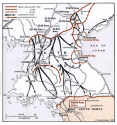Huawei focuses on cloud computing to secure its survival
Chinese company’s fast-growing unit still has access to US chips despite sanctions
Huawei is focusing on its budding cloud business, which still has access to US chips despite the sanctions against the company, to secure its survival.
The Chinese group’s cloud computing business, which sells computing power and storage to companies, including giving them access to AI, is far behind Alibaba and Tencent, the market leaders in China. But it is growing rapidly and in January Huawei put the unit on an equal footing with its smartphones and telecoms equipment businesses.
A person at a Chinese supplier to Huawei said the cloud business was key to Huawei stabilising in its domestic market because Beijing would increasingly support the company through public cloud contracts.
Several people involved in Huawei’s cloud business said the unit was stepping up its offerings. “We will continue to provide customers with a package of [cloud] services and products,” said a person at Huawei familiar with the strategy. “The quality of the chips in it may not be as good as before, but for the other products that are not impacted, we will offer something with a little better quality, and the customers can accept it.”
The change in focus was needed because the outlook for Huawei’s smartphone and other consumer products unit was “hopeless” in the face of a US ban that will choke off its access to mobile chips, said a person familiar with the business. The consumer unit was responsible for half of Huawei’s $122bn revenue last year.
Meanwhile industry executives and analysts said that suppliers of semiconductors needed in cloud computing were still allowed to ship to Huawei, and other components were available on the open market.
“Intel has been the supplier of the main [central processing unit] for Huawei servers as it secured a licence last year that allows it to continue to sell to Huawei,” said a semiconductor industry executive who declined to be named because he is not authorised to speak to the media.
After the US Department of Commerce added Huawei to a list of companies barred from doing business with US companies last year, hundreds of enterprises applied for temporary licences exempting them. Despite rules that the US government imposed in May and on August 17 prohibiting the sale of any chip designed or manufactured using US technology or equipment in any transaction involving Huawei, those licences remain in force.
“The rule has no effect on licences issued prior to Aug 17,” a Department of Commerce official told the Financial Times. “The scope of the rule did not change for those previously issued licences.”
Last year, most companies applying for licences were focused on chip design and software because the industry did not expect Washington to crack down on the entire supply chain, including manufacturing.
Industry experts said that for those Huawei suppliers, the exemption had become meaningless because the latest rule bars the companies that manufacture the chips from shipping to Huawei. But some chipmakers with fabrication plants of their own got licensed. The industry executive and two analysts said Intel was among them.
The Department of Commerce does not publicise which companies receive licences. Intel confirmed it has licences to ship to Huawei.
If Intel CPUs remain available, Huawei could use them to replace the Kunpeng and Ascend, its cloud CPUs developed in-house based on designs from British chip company ARM which can no longer be manufactured because of the recent bans.
Other electronic parts including integrated circuits for power management, memory chips and passive components could be obtained through traders, analysts said. “Channels such as WPG have those on offer,” said YC Yao, a chip analyst at Trendforce, the industry research firm, referring to Asia’s largest distributor of semiconductor components. “I do not think that such transactions could be monitored to the extent that you could prevent sales to a particular end-customer such as Huawei.”

